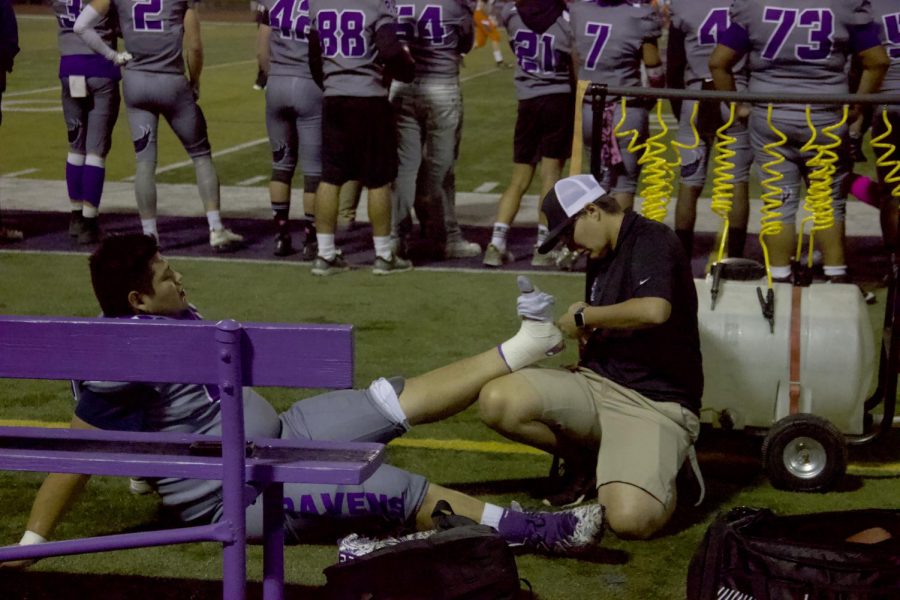New trainer helps heal athletes
January 9, 2020
If an athlete gets injured during a game, Sequoia’s new sports trainer, Sarah Diaz, is the first one on the scene to work with, identify, and help with the recovery of student athletes’ injuries.
It is important for student athletes to have medical help available if they need it. New Sequoia trainer, Sarah Diaz, works with athletes on injury prevention, emergency care, injury diagnosis, and rehabilitation of injuries.
Diaz helps keep Sequoia athletes healthy during their season of sports. Working with these athletes, she has formed relationships with students and is already liked by many of the athletes. Diaz, originally from San Jose, recently moved back to the Bay Area as Sequoia’s new trainer, contracted through Stanford Hospital. Diaz moved to California from Texas after she attended college there and worked as a trainer at a small high school and middle school for two years. Diaz played soccer at Evergreen college, but in her first year she tore her patellar tendon and couldn’t play anymore. Her knee injury caused her to spend a lot of time in the trainers office at her school, which inspired her to become a trainer herself.
Diaz works with the Sequoia athletes s before, after, and during practices and games.
“She is very helpful. She tapes me the way I need to be taped and she’s available whenever you need her,” Senior and varsity Water Polo player Fernanda Pardo said.
Pardo is often in the trainer’s office because she has tendonitis in her elbows and frequently needs to be taped before games. The trainer has been very accommodating to her and student athletes alike, and is always available to athletes whenever needed.
“She’s always there on game days and she’s been pretty easy to communicate with,” Junior and varsity volleyball player Sofia Pompen said.
Diaz gets here early and voluntarily works overtime to make sure Sequoia athletes have the necessary medical attention to perform in their sports. She interacts with about 30-40 students each day.
“If it is an emergency or something serious, I can be here in 20 or 30 minutes. I’m pretty much on call all the time,” Diaz said. “As far as being at school, though, I get here between 2:00 and 2:30, just to help me out so I can get set up for practice before all the kids get out of class,” Diaz said.
The last trainer, Jeff Wilson, was liked by many of the athletes, so Diaz might have felt some initial pressure, but she has already formed relationships with many athletes and many feel like they have a bond with her already, despite the fact that she is new.
“The kids here are awesome. All the coaches have been great. They don’t compare me too much to Jeff [old Sequoia trainer]. I feel like I have some big shoes to fill because everybody loved him. But so far it’s been awesome,” Diaz said.
Diaz is very personable and inviting, so many athletes feel connections with Diaz.
“I didn’t really know Jeff to be able to call it a relationship, but I feel like Sarah and I have this bond,” said Pardo.
Although Diaz’s time here at Sequoia has been short, students have already taken a liking to her and her methods.
“I feel more comfortable with [Diaz]. She’s easier to talk to for me,” Pompen said.
Having a trainer is a privilege and is very important to athletes for staying healthy and being able to compete to their full ability in their sports. Trainers also help schools and students in the long run in different ways.
“I just think [having a trainer] makes things more efficient. I think that we can get players on the field, like recovered faster. As far as money is concerned, because that usually, an issue, I think we save the school and the parents a whole lot of money by being able to tell if something is serious, and if they need to go to the hospital or not,” Diaz said.
Sports injuries are hard to avoid; this year alone, Sequoia athletes have already been involved in many injuries. But Diaz has been available to help athletes recover. With the help from a school trainer, athletes can recover faster, schools and families can save money, and athletes can be healthier in the long run. If athletes get their bodies properly taken care of, many injuries can be prevented and student athletes can continue to play and be apart of a team.







